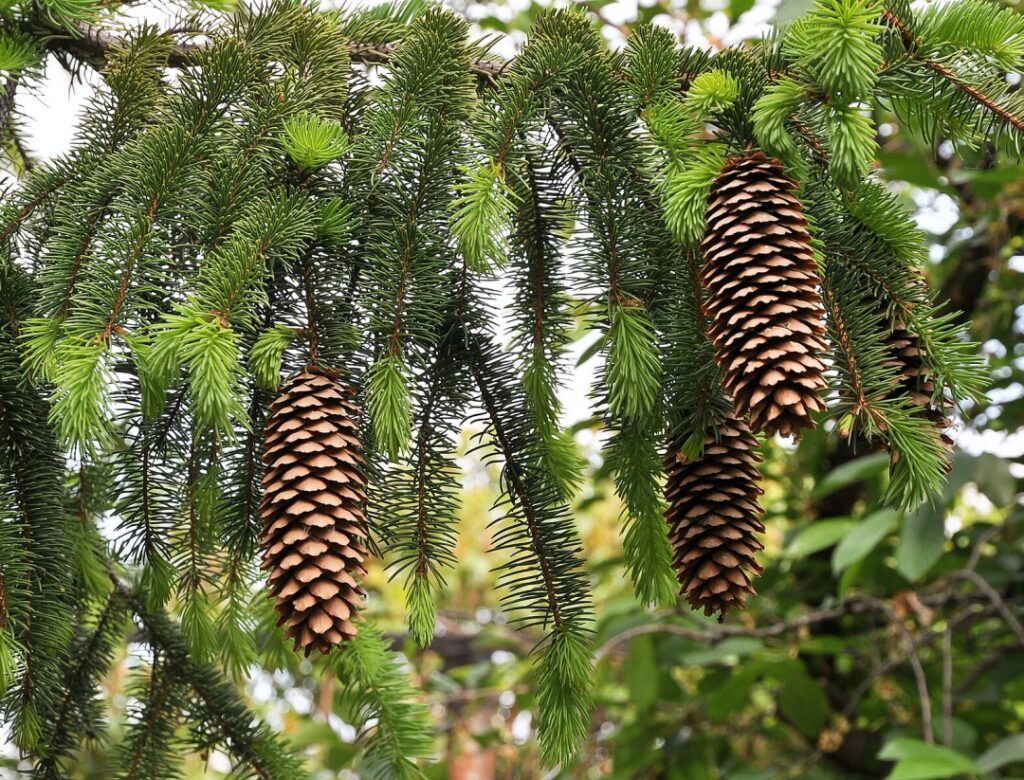
Plamen Agov, CC BY-SA 3.0
Slovakia
Spruce
Picea

Plamen Agov, CC BY-SA 3.0
General Description / Cultural Significance
With over a third of the nation being forest land, Slovakia has selected the Spruce tree, Picea, to represent the picturesque European country. The Norway Spruce is the most popular of the Picea family, and it refreshes the air with a woody, balsamic, and resinous aroma known to all Slovakians.
The Evergreen tree plays a vital role at the forefront of Slovakia’s Maypole celebration. Though most modern-day Slovakian cities and villages display and decorate large spruces in the city center to evoke feelings of freshness and youth, historically, the traditional way looked much different. In the middle ages, the spruce maypole celebration was a mating ritual for boys in Slovakia. The night before the first of May, young men would erect large spruces, and sometimes other evergreens, in the yards of the women they favored. This was a symbolic move; thus, these Picea trees had to be perfect: several feet high, symmetrical, and with a cleaned trunk of branches and bark. In creating the Maypole, the branches at the top were kept in place and decorated with flowers and ribbons. When a wreath was attached to the top of the Maypole spruce, it meant the man intended to marry.
Climate Change / Conservation Status
Over the last few years, persistent drought has destroyed forest ecosystems once dominant in Spruce. Though 2023 has been kinder to the country, with some small pockets of rain in the north, Spruce trees are still in danger. If drought trends continue, Spruce tree numbers are predicted to be reduced by half. In addition, they are now up against a European-wide deterioration of Spruce forests, a decline by soil acidification, toxic pollutants, and insect infestation – such as the Bark Beatle.
Slovakia has a long history of forestry traditions and is continually exploring ways to conserve and restore its forests. Protecting water resources continues to be key to forest management. Since 2009, Slovakia has been working to preserve its old-growth forest – mostly Spruce trees that have ages ranging up to 430 years old.
Alternate Names
épicéa
Sources
Antoni, J., Šomšák, L., & Jansk´y, L. (2000). Reversing the Decline of Secondary Spruce Forests in Slovakia’s Western Carpathians. BioOne Complete, 20(2). https://doi.org/10.1659/0276- 4741(2000)020[0130:RTDOSS]2.0.CO;2
(n.d.). A forest with a 430 year old spruce is now protected in Slovakia. World Wide Fund for Nature. https://wwf.panda.org/wwf_news/?215490/A-forest-with-a-430-year-old-spruce-is-now-protected-in-Slovakia.
(n.d.). Forestry and Peatlands Slovakia. Climate Change Post. https://www.climatechangepost.com/slovakia/forestry-and-peatlands/.
(n.d.). Putting up the maypoles (1st May) is a medieval tradition that continues to this day. Travel to Slovakia. https://slovakia.travel/en/putting-up-of-the-maypoles-1st-may.
(n.d.). Specialities of the Slovak meadows and forests. Travel to Slovakia. https://slovakia.travel/en/specialities-of-the-slovak-meadows-and-forests.
Vančo, M. (2023, June 26). Slovakia did not learn from last year’s drought. The Slovak Spectator. https://spectator.sme.sk/c/23185783/slovakia-extreme-drought.html.
This statement can be found on the original World Sensorium Website.

